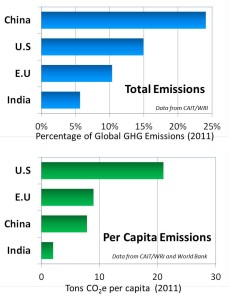What’s Happening with the Big Dogs?
Posted: February 10, 2015
The four “big dogs” of greenhouse gas emissions are China, the US, the EU and India, which together account for more than half of global emissions. The EU is the leader in the climate battle, with the others trailing behind. On the negative side, China is out-doing everyone in both total emissions and overall emissions growth, and India is moving up too. Since 2002, China has shown a growth spurt, increasing emissions by an average of over 8% per year. And India is close to that at about 6% per year average emissions growth. In that same period, both the EU and the US have decreased emissions by about 0.5% per year, although there was a slight uptick in US emissions in 2013, as shown in a European Commission Joint Research Centre 2014 report.
The US and China put their cards on the table in an announcement in November of 2014 that they would each commit to emission reductions. China agreed that its emissions would peak by 2030 and the US, said it would cut carbon emissions by 26%-28% by 2025 compared with 2005 levels. A very good step forward. Now we just need to figure out how to do it.
The US also tried to get a commitment from India. But, Prime Minister Narendra Modi quickly pointed out that India was far behind China and not comparable, noting particularly that over 300 million Indians do not have electricity, and that Indian per capita emissions trail all the other major emitters (see figure). The US and India did agree to cooperation, including a plan to phase out a class of widely used, high Global Warming Potential hydrofluorocarbons, and support solar energy initiatives to help India reach its goal of expanding its solar capacity to 100 gigawatts (gW) by 2022.
The downside in India is that they are also expanding coal production in order to bring electricity to more of their population. The new government announced that they want to double their coal production to to one billion tonnes annually within five years. This will be used primarily to increase their installed electricity by 70 gW by 2017.

No one has left a comment yet.